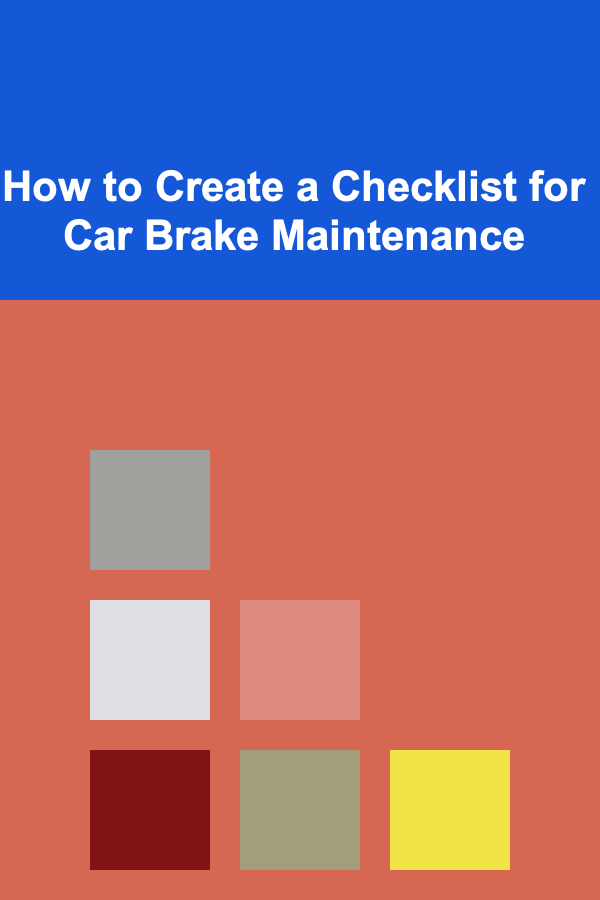
How to Create a Checklist for Car Brake Maintenance
ebook include PDF & Audio bundle (Micro Guide)
$12.99$10.99
Limited Time Offer! Order within the next:

Car brake maintenance is crucial for your safety on the road, ensuring that your vehicle operates efficiently and reliably. Whether you're a car owner looking to maintain your vehicle yourself or a professional mechanic working on clients' cars, a thorough checklist for brake maintenance can significantly improve the lifespan of your brake system while preventing dangerous malfunctions. In this guide, we'll walk through how to create a detailed, actionable checklist for car brake maintenance.
Why Brake Maintenance is Important
The brake system of your car is one of its most critical safety components. Proper brake maintenance ensures that the system functions optimally, helping you stop quickly in emergencies and preventing accidents. Neglecting your brakes can lead to increased repair costs, reduced stopping power, or even brake failure in extreme cases.
Regular brake maintenance also enhances the longevity of various parts like brake pads, rotors, and fluid systems, which can save you money in the long run. Moreover, good brake care improves your car's overall performance and driving comfort.
Components of a Car Brake System
To create an effective checklist, it's important to understand the key components of your car's brake system. These parts need to be regularly checked and maintained to ensure optimal performance:
- Brake Pads: These are the friction material that presses against the brake rotors to create the necessary stopping force.
- Brake Rotors (Discs): These circular discs are attached to your wheels, and brake pads clamp down on them to stop the car.
- Brake Calipers: These are the components that house the brake pads and apply pressure to the rotors.
- Brake Lines and Hoses: These carry brake fluid to the brake calipers.
- Brake Fluid: This hydraulic fluid transmits force from the master cylinder to the brakes.
- Master Cylinder: The heart of the brake hydraulic system, it converts the force you apply to the brake pedal into hydraulic pressure.
- Brake Drums and Shoes (for drum brakes): In some vehicles, instead of rotors and pads, drum brakes use brake shoes and drums to create stopping force.
Step-by-Step Guide to Creating a Brake Maintenance Checklist
1. Check Brake Pads
Why It's Important:
Brake pads are subject to wear over time due to friction. Worn-out brake pads can reduce stopping power and may even damage the rotors.
What to Do:
- Visual Inspection: Inspect the brake pads for thickness. Most brake pads have a wear indicator, which produces a squealing noise when the pads are worn down.
- Thickness Measurement: Measure the thickness of the brake pads. If they are less than 3mm thick, it's time to replace them.
- Check for Uneven Wear: Uneven wear on brake pads may indicate problems such as misalignment, suspension issues, or problems with the caliper.
Actionable Tips:
- Replace the brake pads every 25,000 to 70,000 miles depending on driving habits.
- Consider upgrading to high-performance pads if you drive in mountainous areas or tow heavy loads.
2. Inspect Brake Rotors
Why It's Important:
Rotors are essential for braking. Worn or damaged rotors can lead to inefficient braking and uneven wear on the brake pads.
What to Do:
- Visual Inspection: Look for grooves, cracks, or discoloration on the rotors. Minor grooves are normal, but deep grooves or cracks are signs that the rotors need replacing.
- Measure Rotor Thickness: Use a micrometer to measure the thickness of the rotors. Compare your measurements to the manufacturer's specifications. If the rotors are too thin, replace them.
- Check for Warping: If you feel a pulsating brake pedal when braking, it could be a sign of rotor warping.
Actionable Tips:
- Resurface rotors if they have minor grooves but still meet thickness standards. If they're below the recommended thickness, replace them.
- Rotor replacement is typically necessary every 30,000 to 70,000 miles depending on driving conditions.
3. Inspect Brake Calipers
Why It's Important:
The calipers clamp the brake pads against the rotors to generate stopping force. Damaged or sticking calipers can lead to uneven braking performance and rapid brake pad wear.
What to Do:
- Visual Inspection: Check for signs of rust, fluid leaks, or any physical damage.
- Check for Sticking Calipers: When the vehicle is jacked up, spin the wheels by hand. If one wheel is harder to turn than the other, the caliper may be sticking.
- Check Brake Fluid Leaks: Inspect the area around the calipers for any signs of brake fluid leaks. If you notice leaks, the caliper seals may need replacement.
Actionable Tips:
- Replace any damaged or leaking calipers immediately.
- If calipers are sticking, it may be due to seized pistons. Cleaning or replacing the pistons can help restore functionality.
4. Check Brake Fluid
Why It's Important:
Brake fluid is essential for transferring the force from the brake pedal to the braking components. Low or contaminated brake fluid can lead to brake failure.
What to Do:
- Check Fluid Level: Check the brake fluid reservoir for adequate levels. If the fluid is low, it could be a sign of a leak or worn brake pads.
- Inspect Fluid Condition: Brake fluid should be clear and light in color. If it's dark or murky, it's likely contaminated and should be replaced.
- Flush Brake Fluid: Over time, brake fluid absorbs moisture, which can reduce its effectiveness. It's recommended to flush the brake fluid every 2 years or 24,000 miles.
Actionable Tips:
- Always use the type of brake fluid specified in your owner's manual.
- If you need to top off the fluid, ensure you're using the same brand and type of brake fluid for consistency.
5. Inspect Brake Lines and Hoses
Why It's Important:
Brake lines and hoses carry brake fluid under high pressure to the calipers. Damaged or corroded lines can lead to brake failure.
What to Do:
- Check for Leaks: Look along the brake lines for any signs of leakage. Brake fluid leaks can often be identified by dark spots around the lines.
- Inspect for Corrosion: Check the brake lines for signs of rust or corrosion, especially in areas that may be exposed to moisture or road salt.
- Inspect Hoses: Ensure that the brake hoses are intact and free of cracks or bulges, which could indicate internal damage.
Actionable Tips:
- Replace any corroded or damaged lines and hoses immediately to ensure your brake system works effectively.
- Regularly inspect the lines, especially in climates with harsh winters or high humidity.
6. Test and Inspect the Master Cylinder
Why It's Important:
The master cylinder is responsible for generating hydraulic pressure when you press the brake pedal. A malfunctioning master cylinder can cause inconsistent braking performance.
What to Do:
- Check for Leaks: Inspect the master cylinder for any visible brake fluid leaks around the seals.
- Pedal Feel: Pay attention to the brake pedal feel. If the pedal sinks to the floor or feels soft, the master cylinder may need replacement.
- Test the System: With the engine off, press the brake pedal. If the pedal goes down easily, it may indicate a problem with the master cylinder or a brake fluid leak.
Actionable Tips:
- If the master cylinder is leaking or showing signs of wear, replace it immediately to avoid compromised braking performance.
- Brake pedal issues could also be related to air in the brake lines or low brake fluid levels, so check both areas before replacing the master cylinder.
7. Test the Parking Brake
Why It's Important:
The parking brake is a secondary braking system that holds the car stationary when parked. If it's not working properly, your car could roll away.
What to Do:
- Test the Cable: Ensure that the parking brake cable is functioning and tight enough to engage the brake properly.
- Check the Brake Shoes or Pads: Depending on your vehicle, the parking brake may use either brake shoes or pads. Inspect these for wear.
- Test the Pedal or Lever: Engage the parking brake and ensure it holds the car securely in place.
Actionable Tips:
- If the parking brake doesn't engage properly, adjust the cable tension or replace any worn-out parts.
Conclusion
A comprehensive checklist for brake maintenance is essential to ensure the safety and efficiency of your vehicle. Regularly checking key components like brake pads, rotors, calipers, fluid levels, and lines will prevent costly repairs and help maintain reliable stopping power. Whether you're a DIY enthusiast or a professional, adhering to these maintenance tasks will extend the lifespan of your brake system and ensure that your car is safe to drive. Always consult your vehicle's manual for specific maintenance intervals and consider seeking professional help if you're unsure about any repairs.
Reading More From Our Other Websites
- [Skydiving Tip 101] The Psychology of Freefall: Understanding and Managing Skydiving Nerves
- [Home Soundproofing 101] How to Choose and Install Sound Absorbing Curtains for Maximum Noise Control
- [Screen Printing Tip 101] Step-by-Step Guide: How to Screen Print Your First T-Shirt at Home
- [Weaving Tip 101] The History Behind Two Timeless Crafts: Weaving Meets Macramé
- [Personal Investment 101] How to Leverage Robo-Advisors to Automate Your Investment Portfolio
- [Personal Investment 101] How to Choose Between Active and Passive Investment Strategies
- [Organization Tip 101] How to Use Clear Storage Solutions for Easy Access
- [Home Budget Decorating 101] How to Decorate a Kid's Room on a Budget
- [Home Staging 101] How to Stage a Home with Vintage Finds
- [Personal Care Tips 101] How to Use a Face Mask to Heal and Protect Your Skin

Building a Profitable Business with Deep Learning and AI
Read More
How to Help Small Businesses with Tax Preparation and Filing
Read More
How to Maintain an Organized Toy Area Over Time
Read More
How to Use Dropshipping Suppliers to Manage Returns and Refunds: An Actionable Guide
Read More
How To Patch and Repair Concrete
Read More
How To Find Meaning in the Absurd
Read MoreOther Products

Building a Profitable Business with Deep Learning and AI
Read More
How to Help Small Businesses with Tax Preparation and Filing
Read More
How to Maintain an Organized Toy Area Over Time
Read More
How to Use Dropshipping Suppliers to Manage Returns and Refunds: An Actionable Guide
Read More
How To Patch and Repair Concrete
Read More